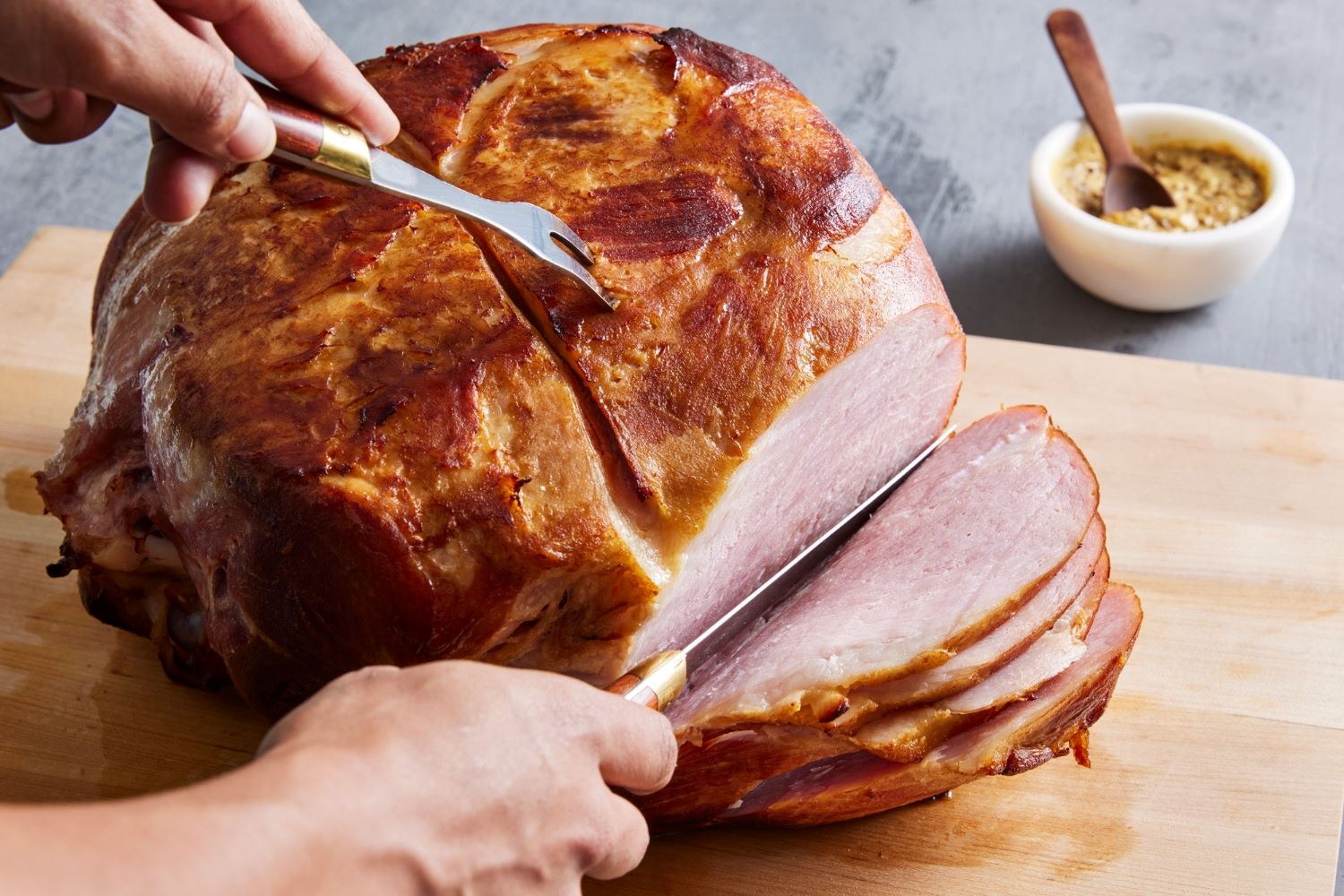Home>Food and Cooking>How To Carve A Spiral Ham


Food and Cooking
How To Carve A Spiral Ham
Published: February 27, 2024
Learn how to carve a spiral ham like a pro with our step-by-step guide. Impress your guests with this delicious and visually appealing dish. Perfect for food and cooking enthusiasts!
(Many of the links in this article redirect to a specific reviewed product. Your purchase of these products through affiliate links helps to generate commission for Noodls.com, at no extra cost. Learn more)
Table of Contents
Introduction
Carving a spiral ham is an art that transforms a humble cut of meat into a centerpiece fit for a feast. Whether you're hosting a holiday gathering, a special occasion, or simply craving a succulent ham, mastering the art of carving a spiral ham is a valuable skill. From choosing the perfect ham to presenting it on the table, every step in the process contributes to a memorable dining experience.
The aroma of a perfectly cooked spiral ham wafting through the air is enough to make anyone's mouth water. The tender, juicy meat, infused with savory flavors, is a delight for the senses. As the main attraction of the meal, a beautifully carved spiral ham not only satisfies hunger but also serves as a symbol of warmth, togetherness, and celebration.
In this guide, we will delve into the intricacies of selecting the right spiral ham, preparing it to perfection, and, of course, the art of carving. Whether you're a seasoned chef or a novice in the kitchen, this comprehensive tutorial will equip you with the knowledge and skills to carve a spiral ham like a pro. So, roll up your sleeves, sharpen your knife, and let's embark on a culinary journey that will elevate your dining experience to new heights.
Choosing the Right Spiral Ham
When it comes to selecting the perfect spiral ham, several factors come into play. The first consideration is the size of the ham, which largely depends on the number of guests you plan to serve. A general rule of thumb is to estimate about 1/2 pound of ham per person if the ham is the main course.
Next, consider the type of spiral ham. There are various options available, including smoked, honey-glazed, and brown sugar-cured hams. Each type offers a distinct flavor profile, so it's essential to choose one that complements your personal taste and the overall menu.
Furthermore, the quality of the ham is paramount. Look for a ham with a good marbling of fat, as this contributes to the tenderness and juiciness of the meat. Additionally, opt for a ham that is free from excessive additives and preservatives, as a more natural ham often yields superior flavor.
When purchasing a spiral ham, consider whether you prefer bone-in or boneless. While bone-in hams tend to have richer flavor due to the bone marrow, boneless hams offer convenience in slicing and serving.
Lastly, take note of the ham's packaging. Ensure that the ham is well-sealed and has not surpassed its expiration date. If possible, opt for a ham from a reputable butcher or supplier to guarantee its freshness and quality.
By carefully considering these factors, you can ensure that the spiral ham you choose is not only the right size and type for your gathering but also of the highest quality, promising a delectable dining experience for you and your guests.
Preparing the Spiral Ham
Before the art of carving can commence, preparing the spiral ham is a crucial step that sets the stage for a delectable dining experience. The preparation process involves several key elements that contribute to the flavor, texture, and overall appeal of the ham.
Thawing and Preheating
If your spiral ham is frozen, it's essential to allow ample time for it to thaw properly. The safest method is to thaw the ham in the refrigerator, allowing approximately 24 hours for every 5 pounds of ham. Once thawed, remove the ham from the refrigerator and let it sit at room temperature for about 1-2 hours before cooking.
Preheat the oven to the recommended temperature specified on the ham's packaging. This ensures that the ham cooks evenly and retains its natural juices, resulting in a tender and succulent texture.
Seasoning and Glazing
Before placing the ham in the oven, consider seasoning it to enhance its flavor profile. A simple yet effective seasoning blend may include a combination of brown sugar, honey, Dijon mustard, and a hint of cloves or other aromatic spices. Gently score the surface of the ham in a diamond pattern to allow the seasonings to penetrate the meat, then generously apply the seasoning blend, ensuring that it coats the entire surface.
For those who prefer a glazed finish, a mixture of honey, brown sugar, and a touch of citrus juice can be brushed over the ham. This glaze caramelizes during the cooking process, imparting a delightful sweetness and a glossy sheen to the ham's exterior.
Cooking and Basting
Place the prepared spiral ham in a roasting pan, ensuring that it is positioned with the cut side facing down. Cover the ham with aluminum foil to retain moisture during the initial phase of cooking. The cooking time varies depending on the size of the ham, typically requiring 15-20 minutes per pound in a preheated oven.
Throughout the cooking process, periodically baste the ham with its natural juices or the prepared glaze. This not only enhances the flavor but also helps to keep the meat moist and tender.
By meticulously preparing the spiral ham with attention to thawing, seasoning, and cooking techniques, you set the stage for a culinary masterpiece that will captivate the senses and leave a lasting impression on all who partake in the feast.
Carving the Spiral Ham
Carving a spiral ham is the culmination of the culinary journey, where the artistry of preparation meets the precision of presentation. As you embark on this final phase, envision the satisfaction of unveiling perfectly sliced, succulent ham that beckons with its aroma and promises a symphony of flavors.
Tools of the Trade
Before diving into the carving process, ensure you have the right tools at your disposal. A sharp carving knife with a long, thin blade is essential for achieving clean, even slices. A carving fork or meat claws can provide stability and control while carving, preventing the ham from slipping during the process.
Positioning and Slicing Technique
Begin by placing the spiral ham on a sturdy cutting board, ensuring a stable surface for carving. Identify the natural lines of the spiral slices, which serve as a guide for uniform cuts. Starting at the top of the ham, near the bone, gently insert the carving knife along the natural seams, allowing the blade to follow the contours of the slices.
Uniformity and Presentation
Maintain a consistent angle and depth as you slice through the ham, aiming for uniform portions that showcase the intricate spiral pattern. As each slice is released, arrange it on a serving platter or directly onto individual plates, ensuring an elegant and appetizing presentation.
Serving Suggestions
The art of carving a spiral ham extends beyond the technical process to encompass the art of serving. Consider accompanying the ham with an array of complementary condiments, such as whole grain mustard, fruit chutney, or a tangy glaze. These additions elevate the flavor profile and offer guests the opportunity to customize their dining experience.
Culinary Creativity
While tradition often dictates the classic approach to carving and serving spiral ham, don't hesitate to infuse your own creativity and flair. Experiment with different garnishes, such as fresh herbs or citrus zest, to add a vibrant touch to the presentation. Embrace the opportunity to showcase your personal style and culinary ingenuity.
The Finishing Touch
As the last slice of ham is delicately placed on the serving platter, take a moment to admire the masterpiece you've created. The culmination of meticulous preparation and skillful carving has resulted in a culinary centerpiece that embodies the essence of indulgence and conviviality.
Carving a spiral ham is not merely a culinary task; it is a celebration of craftsmanship and a testament to the joy of sharing a memorable meal with loved ones. With each slice, you impart not only the flavors of the ham but also the warmth of hospitality and the spirit of togetherness.
Serving and Storing the Spiral Ham
Once the spiral ham has been expertly carved and presented, the focus shifts to serving and storing this culinary masterpiece. The manner in which the ham is served and the subsequent storage of any remaining portions are pivotal in preserving its flavor and ensuring a delightful dining experience for days to come.
Serving with Elegance
When serving the spiral ham, attention to detail elevates the experience. Arrange the slices on a platter or serving dish, allowing the intricate spiral pattern to showcase the artistry of the carving process. Consider garnishing the platter with fresh herbs, such as rosemary or thyme, to add a touch of vibrancy and fragrance. Additionally, offering a selection of condiments, such as tangy mustard, sweet fruit preserves, or a zesty glaze, provides guests with the opportunity to customize their ham to their liking.
Accompany the ham with an array of complementary side dishes, such as roasted vegetables, buttery mashed potatoes, or a crisp garden salad. The interplay of flavors and textures creates a harmonious dining experience, where each element enhances the enjoyment of the succulent spiral ham.
Storing for Freshness
After the meal, proper storage of any remaining spiral ham is essential to maintain its flavor and texture. Once the ham has cooled to room temperature, carefully wrap the leftover slices in plastic wrap or aluminum foil, ensuring a tight seal to prevent exposure to air. Alternatively, transfer the slices to an airtight container, minimizing the risk of moisture loss and preserving the ham's juiciness.
Refrigerate the wrapped or containerized ham promptly, ensuring it is stored at a consistent temperature of 40°F (4°C) or below. Proper refrigeration helps to inhibit bacterial growth and maintain the ham's quality for an extended period. When stored correctly, leftover spiral ham can retain its flavor and tenderness for up to five days, allowing for enjoyable meals and culinary creations beyond the initial serving.
Culinary Versatility
The versatility of leftover spiral ham extends beyond reheating slices for subsequent meals. Embrace the opportunity to incorporate the ham into an array of culinary creations, such as hearty soups, flavorful omelets, or savory quiches. The rich, smoky notes of the ham infuse these dishes with depth and complexity, offering a delightful departure from traditional preparations.
By serving the spiral ham with elegance and storing any remaining portions with care, you ensure that the culinary journey extends beyond the initial feast. The flavors and memories associated with the ham linger, inviting further enjoyment and culinary exploration in the days that follow.












